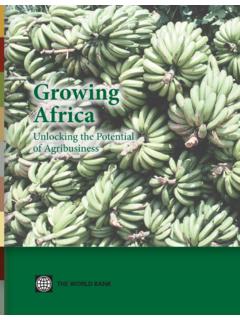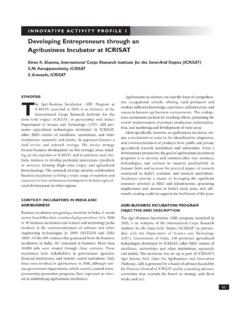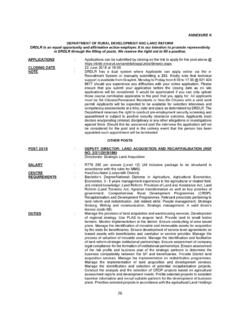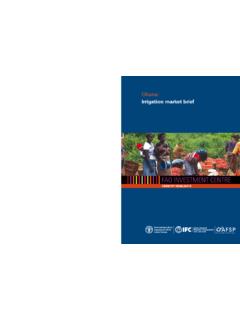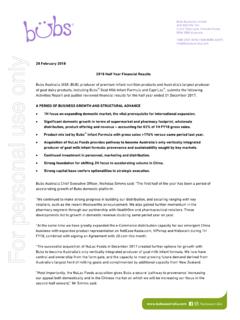Transcription of Contract farming. Partnerships for growth
1 Contract farmingPartnerships for growthFAOAGRICULTURALSERVICESBULLETIN145 ISSN 000-000 Inside front coverContract farmingPartnerships for growthFAOAGRICULTURALSERVICESBULLETIN145 A guidebyCharles EatonandAndrew W. ShepherdRome, 2001 FAO 2001iiiPrefaceContract farming has been in existence for many years as a means of organizingthe commercial agricultural production of both large-scale and small-scalefarmers. Interest in it continues to expand, particularly in countries thatpreviously followed a central planning policy and in those countries that haveliberalized marketing through the closing down of marketing boards.
2 Changesin consumption habits, such as the increasing number of fast-food outlets, thegrowing role played by supermarkets in many countries, and the continuedexpansion of world trade in fresh and processed products, have also providedthe impetus for further development of this mode of purpose of this guide is not to replicate past socio-economic studies onthe subject of Contract farming . Rather, the aim is to provide advice: first, tomanagement of existing Contract farming companies on how to improve theiroperations; second, to companies that are considering starting such ventureson the preconditions and management actions necessary for success; and, lastbut not least, to government officials seeking to promote new Contract farmingoperations or monitor existing operations.
3 The guide describes in detail thegeneral modus operandi, internal functions and monitoring mechanisms ofcontract farming . It emphasizes that sustainable Contract farming arrangementsare only possible when the various parties see themselves involved in a long-term and referencesixIntroduction1 Chapter 1 ADVANTAGES AND PROBLEMSOF Contract FARMING7 Advantages for farmers10 Problems faced by farmers14 Advantages for sponsors18 Problems faced by sponsors22 Chapter 2 KEY PRECONDITIONSFOR SUCCESSFUL Contract FARMING27A profitable market30 The physical and social environments31 Government support36 Inventories of preconditions40 Chapter 3 TYPES OF Contract FARMING43 The
4 Centralized model47 The nucleus estate model50 The multipartite model50 The informal model52 The intermediary model54viContents, continuedChapter 4 CONTRACTS AND THEIR SPECIFICATIONS57 The legal framework61 The formula62 The format66 The specifications68 Chapter 5 MANAGING THE PROJECT83 Coordinating production86 Managing the agronomy94 Farmer-management relations100 Chapter 6 MONITORING PERFORMANCE105 Monitoring quality and yields108 Monitoring human resources115 Protecting the environment117 Annexes119 Glossary149 References and further reading153viiFigures1A Contract farming framework42 The centralized model493 The multipartite model A joint-venture Contract farming project in
5 China51 Boxes1 Technology transfer by diffusion132 Effect of assured markets Tomato production in India143 Analysing the physical and social environment334 Culture versus commercialism355 Sugar-cane production by Contract farming in Thailand486 Individual developers The informal model537 Intermediaries in Thailand558 Acts of God clauses in contracts639 Land tenure for Contract farming6510 Transient verbal contracts6711An example of grading specificationsfor fresh tobacco leaf7012 The role of farmer groups in Colombia9013 Growers Association in Kenya9114 Management and technology transfer in India9615 Monitoring milk production in Croatia110viiiTables1aExample of an inventory of preconditionsfor Contract farming Socio-political assessment411bExample of an inventory of preconditionsfor Contract farming Physical and social assessment422 Characteristics of Contract farming structures563 Characteristics of Contract formulas644 Pricing and grading structure of cassavaunder Contract in Thailand765A cropping schedule for flue-cured tobaccounder contract996 Production and postharvest matrix for export papayaunder
6 Contract114 Annexes1 Sponsor-farmer advance policies1212 Agreement for Contract farming of maize1243 Tobacco Contract Greece1264 Export papaya agreement1315 Swine raising Contract Thailand1326 Job description for field extension officers1387 Calculated yield indicators (CYI)1408 Farmer performance record1439 Quality constraints An illustration of perceptions146ixAcknowledgementsand referencesThe assistance of Cynthia Donovan, Jon Lindsay, Marco Prencipe, RichardRoberts, Morton Satin, Elizabeth Scott, Ian Tankard, and Mitchell Williamsonin the preparation of this publication is gratefully acknowledged.
7 SupanunBoontoay, Arunee Pinprayong, Prayong Saiprasert and Chotiroj Wongwanprovided considerable assistance to the senior author during a research visit toThailand. The help provided by the British American Tobacco Company andthe Nestle Corporation in Malaysia, the Frito-Lay and Betagro companies inThailand, and the Lakson Company in Pakistan, which freely providedproduction data and operational details of their smallholder farming operations,is acknowledged with case studies commissioned by FAO were carried out by LuzBerania D az in Colombia, Kelvin Craig in Guyana, Tajamul Haque in India,Patrick Kambewa in Malawi, Sandra Kokoric in Croatia, Enriqueta Torres inthe Philippines, and Tom Reuben Wambua in Kenya.
8 Antony Ellman, StevenJaffee and Andrew Tallach kindly reviewed an advanced draft of this publicationand made many valuable comments. However, responsibility for errors andomissions and the interpretation of the topic remains that of the considerable debt is owed to the employees and farmers of contractfarming ventures in many countries who have contributed to the subject ofcrop agreements and management-farmer relationships. By sharing theirknowledge and experiences they provided the inspiration and interest that madethis publication references are made in the text to specific Contract farmingexperiences, the source is usually acknowledged as a footnote.
9 Where noacknowledgement is given, the source is either one of the unpublished casestudies mentioned above or the unpublished experiences of the authors, inparticular those of Charles farming1 IntroductionIn an age of market liberalization, globalization and expanding agribusiness,there is a danger that small-scale farmers will find difficulty in fully participatingin the market economy. In many countries such farmers could becomemarginalized as larger farms become increasingly necessary for a profitableoperation. A consequence of this will be a continuation of the drift ofpopulations to urban areas that is being witnessed almost by governments and development agencies to arrest this drift havetended to emphasize the identification of income generation activities forrural people.
10 Unfortunately there is relatively little evidence that such attemptshave borne fruit. This is largely because the necessary backward and forwardmarket linkages are rarely in place, rural farmers and small-scaleentrepreneurs lack both reliable and cost-efficient inputs such as extensionadvice, mechanization services, seeds, fertilizers and credit, and guaranteedand profitable markets for their output. Well-organized Contract farming does,however, provide such linkages, and would appear to offer an important wayin which smaller producers can farm in a commercial manner.










